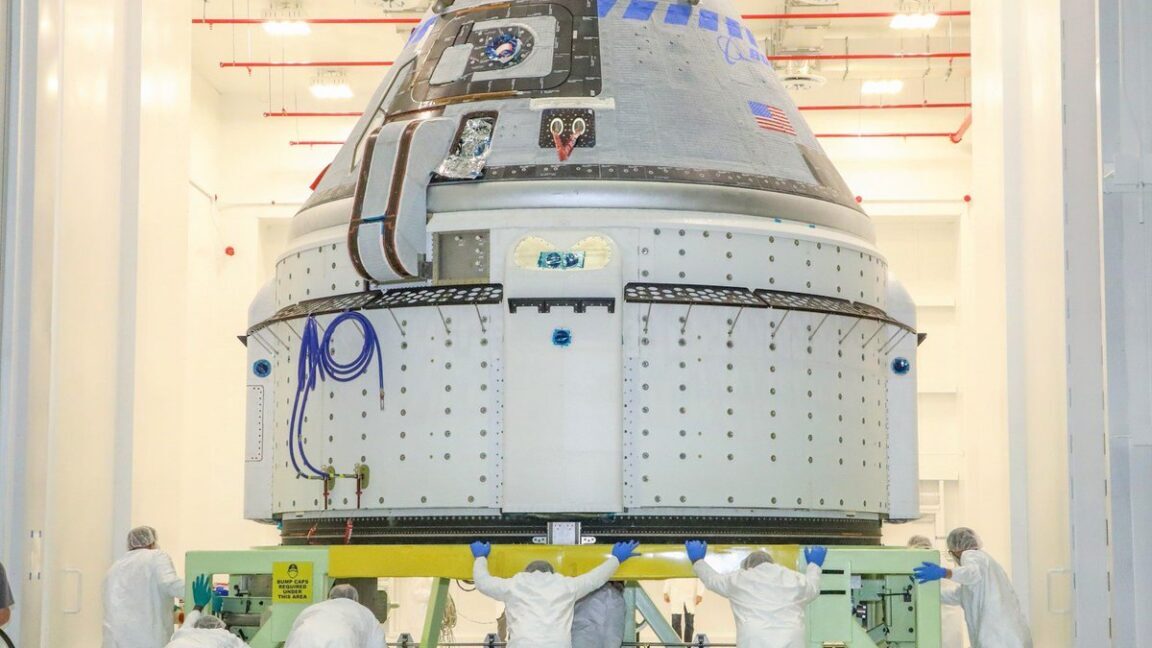25.11.2025
As the space station nears its end, NASA also cuts some future Starliner flights.

The CST-100 Starliner spacecraft to be flown on Boeing’s Orbital Flight Test (OFT-1) is viewed Nov. 2, 2019. Credit: Boeing
The US space agency ended months of speculation about the next flight of Boeing’s Starliner spacecraft, confirming Monday that the vehicle will carry only cargo to the International Space Station.
NASA and Boeing are now targeting no earlier than April 2026 to fly the uncrewed Starliner-1 mission, the space agency said. Launching by next April will require completion of rigorous test, certification, and mission readiness activities, NASA added in a statement.
“NASA and Boeing are continuing to rigorously test the Starliner propulsion system in preparation for two potential flights next year,” said Steve Stich, manager of NASA’s Commercial Crew Program, in a statement.
Reducing crewed missions
NASA also said it has reached an agreement with Boeing to modify the Commercial Crew contract, signed in 2014, that called for six crewed flights to the space station following certification of the spacecraft. Now the plan is to fly Starliner-1 carrying cargo, and then up to three additional missions before the space station is retired.
“This modification allows NASA and Boeing to focus on safely certifying the system in 2026, execute Starliner’s first crew rotation when ready, and align our ongoing flight planning for future Starliner missions based on station’s operational needs through 2030,” Stich said.
SpaceX and Boeing were both awarded contracts in 2014 to develop crewed spacecraft and fly six operational missions to the space station. SpaceX, with its Crew Dragon vehicle, flew a successful crew test flight in mid-2020 and its first operational mission before the end of that year. Most recently, the Crew-11 mission launched in August, with Crew-12 presently scheduled for February 15.
Dragon has served as a reliable transport system for NASA as Boeing has faced development struggles.
Starliner’s first flight in December 2019, without crew, had to be truncated after software problems plagued the vehicle. It was nearly lost shortly after launch as well as before atmospheric reentry. It did not make a planned rendezvous with the space station.
The second mission, Orbital Flight Test 2, took place in May 2022. Because of problems on the previous mission, this spacecraft also flew uncrewed. This flight was more successful, reaching the space station despite some thruster issues.
Orbital Flight Test 3?
NASA then spent more than two years testing Starliner on the ground before its first crewed flight in 2024, carrying NASA astronauts Butch Wilmore and Suni Williams. During its approach to the space station, the Starliner spacecraft once again experienced serious thruster issues. (However, the life-and-death nature of this flight was not revealed until nearly a year later.) Starliner ultimately docked with the station, but after heated deliberations, NASA informed Boeing that the vehicle would return to Earth uncrewed.
As a result, a Dragon mission was launched later in 2024 carrying just two astronauts instead of a full complement of four. This allowed for the safe return of Wilmore and Williams in March 2025.
Since then, it has appeared likely that Boeing would be required to fly an uncrewed mission to demonstrate the safety of Starliner’s propulsion system, but this was not confirmed until Monday.
NASA has remained largely mum about the changes made to Boeing’s propulsion system and the tests it has undergone on the ground. Part of the problem with diagnosing the thruster issues is that the problems occurred in the “service module” portion of the spacecraft, which is jettisoned before the vehicle reenters Earth’s atmosphere and returns to Earth.
Quelle: arsTechnica
